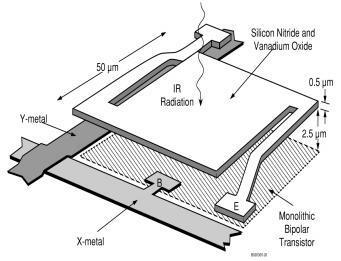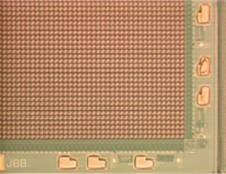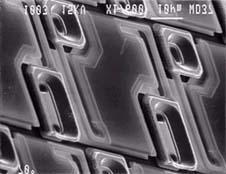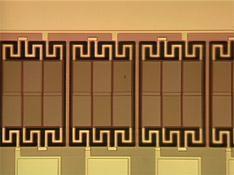非制冷热传感器技术与进出口
非制冷热传感器技术与进出口
很多人和很多客户不是很清楚为什么有些热像仪进口非得要中国商务部和热像仪生产国商务部的批准证书,经常对此提出疑问,请大家仔细看看本网页的说明。
实际上,热像仪如果是非制冷微型热辐射计探测器和帧频大于9Hz,那么就必须要获得中国商务部和生产国商务部的批准,才可以出口。
A paradigm shift has occurred in the commercial infrared camera industry as a result of classified military thermal sensor development in the 1980’s. In the past most high performance infrared cameras used in commerce had photon-detection sensors that needed to be cooled to liquid nitrogen temperature (77K). Cryogenic coolers were used to cool the detectors requiring about 10 minutes turn-on time to achieve this very low temperature. New high performance cameras use thermal sensors that eliminate the need for cryo-coolers. Their turn-on time is 15 seconds less.
Cryo-coolers are expensive have wear-out issues. The elimination of the cryo-cooler advances in electronics has made the cameras smaller, more reliable less expensive.
热传感器
红外热传感器原理图如右图所示。A tiny thin plate (which I call a “platelet”) is made on a silicon wafer in a silicon foundry by a micro-machining process. The platelet is typically 50 m (microns) square by 0.5 m thick. Even smaller sizes are under development. Long thin support legs a vacuum environment thermally isolates it the substrate. Small thermal radiation the target focused onto the platelet heats it. The higher the target temperature, the greater the focused radiation is therefore the higher the platelet temperature.
The temperature of the platelet therefore the intensity of the radiation can be measured by the change in resistance of an electrical resistor deposited on the platelet -- the microbolometer sensor. It can be measured by a thermocouple with the hot junction on the platelet the reference junction on the substrate -- the thermoelectric sensor. it can be measured by an electrical capacitance effect -- the pyroelectric sensor. The microbolometer was developed by Honeywell is used in Infrared Solutions, Inc. cameras.

微型测辐射热仪技术
Individual sensor elements use the change in electrical resistance of a VOx resistor deposited onto the tiny “platelets” fabricated by silicon micro-machining in a silicon foundry. Incoming target radiation heats the VOx causing a change in electrical resistance, which is readout by measuring the resulting change in bias current. 80,000 more sensors can be fabricated together into a two-dimensional array. The structure can be dimensioned to operate at 30 Hertz. That is, the thermal conductance of the isolating legs can be adjusted to match the time-constant for 30-hertz operation. An example of a microbolometer element is pictured below. | |
It consists of a two-layer structure. An interconnecting readout circuitry is applied to the silicon process wafer then the microbolometer structure is built on top of the readout circuitry. First a pattern of islands _ wavelength thick are deposited on the readout circuitry. The islands are made of a material that can be selectively etched away later to form a bridge structure. Three layers -- silicon nitride, vanadium oxide, silicon nitride -- are deposited over the sacrificial islands. The sacrificial islands are then etched away leaving the thermally isolated bridge structure of vanadium oxide. A photo of an early Honeywell microbolometer element is shown in the picture below followed by a photo of one corner of a 320 by 240 microbolometer array |



现在大多数热像仪制造商都使用320x240像素的微型热辐射仪阵列探测器。然而依然有一款极优越的可替代品-160x120的阵列探测器,虽然阵列小,但制造出的热像仪价格却价格低很多。更多Far more arrays can be produced on a single wafer the yield is higher for the smaller array. In addition, one of the most expensive components of an infrared camera is the lens its cost is proportional to the array size.
The only advantage of the larger array is field of view (FOV). With the same f# focal length lens the same detector size, a camera with 320 by 240 160 by 120 will have identical spatial resolution. But the target size for a fixed distance between the camera target will be twice as large in both dimensions for the camera with the larger array. For many commercial applications the cost savings of the smaller array size over shadows the advantage of a larger FOV.
一些历史事实
20世纪80年代,美国国防部给Honeywell和Texas Instruments (TI) 2个公司很多大型机密的合同,开发非制冷红外传感器技术。军事用途要求一种传感器可以极短时间能工作。这2个计划都非常成功,TI公司开发出了焦热电传感器,Honeywell公司开发出了微型测辐射热仪(微型热辐射仪)。
1992年美国政府为商用产品从机密表中删除了红外技术的应用一项,但保留了对技术的控制。TI公司利用它们的传感器技术开发出了商用热像仪,Honeywell则开始向其它公司发放许可证允许他们使用微型测热辐射仪技术。
最初有4个公司购买了微型测热辐射仪使用证书。Loral公司收购了Honeywell的 光电部门(Electro Optics Division),获得了一个使用证书。Santa Barbara Research是Hughes, Amber Engineering的一个部门, 与Amber Engineering及Rockwell也都购买了使用证书。所有这4个证书也都曾经转手过,而且有些还不止一次。Loral后来被Lockheed Martin收购, Lockheed Martin后来将微型测热辐射仪机构应用到他们的Sanders运作中,而这个项目后来又被英国航天航空(British Aerospace)收购。Raytheon (雷神)则从Hughes收购了Santa Barbara Research并收购了Amber Engineering。波音公司收购了Rockwell的红外机构,几年以后又把它卖给了DRS技术公司。所以最初的4个有证书的公司目前变成了3个:英国航天航空(British Aerospace), Raytheon(雷神)和DRS技术公司(DRS Technologies)。
有3个另外的公司也购买了使用证书,分别是Indigo Systems, InfraredVision技术公司以及蕞新购买的公司NEC。除了这6个公司,Institut National d’Optique (INO), 有有限使用的证书。
热像仪技术
过去红外热像仪多使用特殊材料制成的传感器,这些特殊材料需要带液态氮冷却,冷却温度可到-320℉ (-195℃)。这方面的技术突破是因为军事研发取得的,使得生产非制冷、高性能的测量和传感红外能量的传感器成为可能。这种新型非制冷技术受商业用途的刺激,使得红外技术的应用显现出巨大的商机。
这种非制冷技术也使得开发新型、低成本、易操作的2维探测器红外成像设备成为可能。这种红外成像设备,如德国DIAS红外系统公司的便携式热像仪MIDAS 320L或PYROVIEW 320/380/640N等设备,可以立即“看到”整个景色,可以在视频设备中产生实时的图像。
